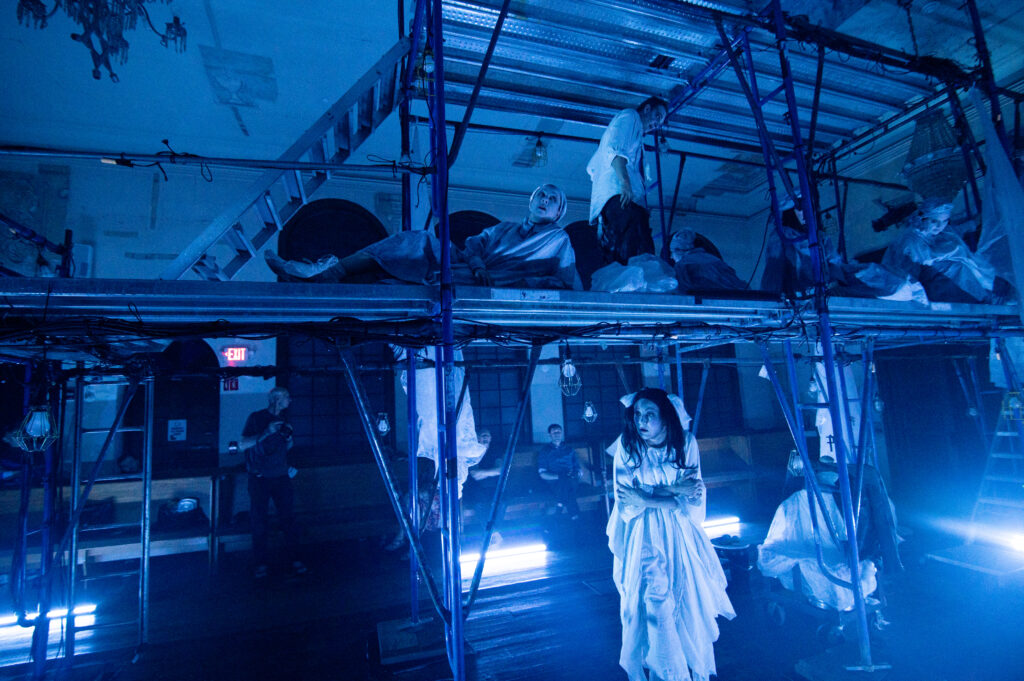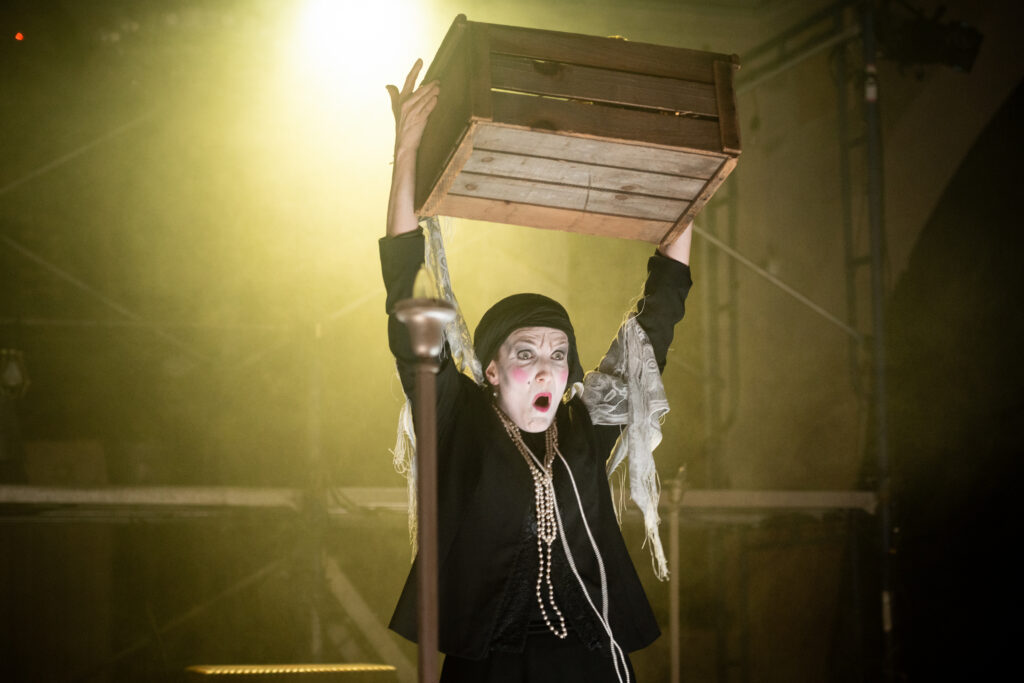
Andrey Burkovskiy & Yana Gladkikh. Photo by Irina Danilova
Presented by Arlekin Players
Written by Roy Chen based on the original play by S. Ansky
Adapted by Igor Golyak with Dr. Rachel Merrill Moss
With additional material from the translation by Joachim Neugroschel
Directed by Igor Golya
Jewish Music Consultant: Anthony Russell
Compositions and Sound Design by Fedor Zhuravlev
Dramaturgy by Dr. Rachel Merrill Moss
Featuring: Andrey Burkovskiy, Yana Gladkikh, Olga Aronova, Jenya Brodskaia, Polina Dubovikova, Anna Furman, Boris Furman, Rimma Gluzman, Gene Ravvin, Juliya Shikh, Olga Sokolova, Irina Vilenchik, with Deb Martin, Robert Walsh
May 30 – June 23, 2024
The Vilna Shul
Boston’s Center for Jewish Culture
18 Phillips St.
Boston, MA 02114
Critique by Kitty Drexel
BOSTON, Mass. — The 2024 performance of The Dybbuk; Between Two Worlds occurs in Beacon Hill’s Vilna Shul, a century-old synagogue. A 20th century Polish ensemble called the Vilna Troupe premiered playwright and activist S. Ansky’s play, The Dybbuk; Between Two Worlds in Warsaw after observing 30 days of traditional mourning for Ansky’s death in 1920. The troupe split into smaller groups, toured the play through Europe, and it became famous.
The Vilna Shul was built in 1919 near the time of the premier but the Vilna Trouple did not perform The Dybbuk in Boston’s Vilna Shul. The Vilna Troupe originally performed Ansky’s play and now Arlekin Players are performing it in the Vilna Shul. Igor Golyak said through a press rep that the concurrence of these events has invited the spirits of the original troupe to live in the walls of this historic synagogue.
Arlekin Player’s production is based on Ansky’s play of the same name. Both are about a tragic love story in a turn-of-the-century shtetl about a young woman possessed by a dybuk, a restless, disembodied human spirit from Jewish folklore that wanders the earth because of past sins.
In Arlekin’s version, Khonen/the Dybbuk (Andrey Burkovskiy) loves Leah (the ethereal voiced Yana Gladkikh). When Khonen learns Leah is betrothed to Menashe (Fedor Zhuravlev), Khonen dies by suicide. Leah is possessed by a dybbuk on the day of her wedding. Her grandmother Frade (Deb Martin, whose work is best described as Norma Desmond meets Frau Blücher), and her father Sender (Robert Walsh) attempt to exorcize the dybbuk, but it will not go. Khonen and Leah discover their love between the world of the living and death.

Photo by Irina Danilova
Arlekin’s The Dybbuk; Between Two Worlds is an electric performance that spans across the ages and two levels of scaffolding. Burkovskiy and Gladkikh dominate the stage as Khonen and Leah. Their athletic performances contain elements of mime, clowning technique and draw from Vaudville traditions. They are supported by the performances of Martin and Walsh, whose intense work is so excellently stylized it borders on the grotesque.
The performance space in the beautiful Vilna Schul is undergoing renovations. The renovations add to the otherworldliness of the scenic design by Igor Golyak and Sasha Kuznetsova. Stripped walls, crumbling plaster, and scaffolding lend to the play’s liminal ethos. Arlekin Players do their best to keep attendees clean, but there is a lot of dust. Sensitive attendees may find it beneficial to take an antihistamine or wear a mask during the performance.
The sound design by Fedor Zhuravlev propelled The Dybbuk’s believability to the next level. Whether we were witnessing disembodied laughter that uncannily traveled from upstage to down or grooving to La Bouche’s “Be My Lover,” the sound design and execution were integral to the show’s reality. His beautiful compositions sound like they were straight out of a fairy tale.

Deb Martinas as Frade. Photo by Irina Danilova.
Jeff Adelberg creatively suspended hand lamps from the set’s scaffolding to cast ghostly shadows onto the actors and into the audience. LED tube lamps lined the room’s walkways before the performance and were used as hand props during the show. Adelberg’s designs created a rich atmosphere for storytelling during the performance. The Vilna Shul is a found performance space. As there isn’t devoted rigging for lighting equipment, there are lights rigged at eye level to some seats. This may concern attendees with sensitive eyes.
The theatre style of The Dybbuk; Between Two Worlds points more towards experimental theatre than it does traditional Western theatre. Anyone familiar with Arlekin’s work should get excited for more daring art. Newbies should gird their loins. Your mind is about to be blown. Enjoy it while it lasts.
Update June 7, 2024: A previous version of this article incorrectly implied that the Vilna Troupe performed in the Vilna Shul. Updates have corrected this misstatement. We thank the Arlekin Players for the corrections and patience.
